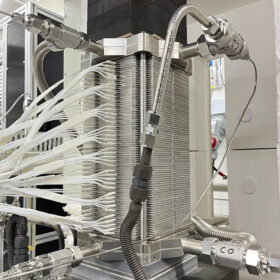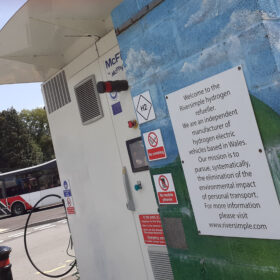The Hydrogen Stream: Hyundai Motor plans fuel cell plant in South Korea
Hyundai Motor says it plans to build its first hydrogen fuel cell systems plant in South Korea by 2028, pending union consultations, expanding beyond its existing facility in China.
US startup offers reversible fuel cell for remote locations
HyWatts has developed the Powerplant-in-a-Box system, a reversible high temperature proton exchange membrane fuel cell that can also work as an electrolyzer, ensuring energy supply anywhere and anytime.
Novel fuel cell tech based on silicon-based bipolar plates
Australia’s Clean Energy Finance Corporation has backed a hydrogen fuel cell developer $7 million to support an innovative form of technology using silicon-based bipolar plates.
The Hydrogen Stream: MIT shows hydrogen can be made from aluminum, caffeine
Researchers from the Massachusetts Institute of Technology (MIT) claim they can efficiently produce hydrogen from recycled aluminum cans in seawater by combining them with gallium-indium and caffeine.
Offgrid PV-driven hydrogen vs. standalone solar-plus-storage
A German research team has compared the economic performance of an offgrid PV-electrolyser-fuel cell system with that of a standalone solar-plus-storage counterpart in a building in Niger. Its analysis showed that decentralized PV-driven hydrogen could achieve considerable lower levelized cost of energy and levelized cost of storage than the PV-battery system, with these values reaching €0.12 ($13.1)/kWh and €0.35/kWh, respectively.
Hybrid hydrogen-battery system for off-grid PV-powered homes
Conceived by a Dutch research group, the proposed system is intended to store surplus renewable electricity via hydrogen generation and battery storage, with the latter being used only when hydrogen generation is not immediately available. Despite its high initial costs, the system can reportedly offer stable operation.
Low platinum fuel cells for hydrogen vehicles
New research from Sweden suggests that low platinum fuel cells for hydrogen vehicles, when scaled up for the same number of cells, may achieve similar or higher efficiencies compared to commercial fuel cells. Their modeling is expected to act as a bridge between material science research and vehicle implementation.
PV-driven hybrid hydrogen fuel cell system for building applications
Scientist in Canada have proposed to combine rooftop PV power generation with an alkaline electrolyzer and a fuel cell to generate hydrogen in buildings. The new system is intended at enabling seasonal energy storage and reduce a home’s levelized cost of energy.
Korean researchers build 8 kW solid oxide electrolysis cell that can produce 5.7 kg of hydrogen per day
The Korea Institute of Energy Research has developed a solid oxide electrolysis cell stack that uses a special kind of separator plate to ensure proper flow of hydrogen and oxigen after water splitting. Samsung Electro-Mechanics and Bumhan Industries are now cooperating with the research center to improve relevant manufacturing process.
When nano- meets climate technology
The use of metal-organic frameworks (MOFs) to create nanoscale crystal structures to attract hydrogen molecules could drastically improve the energy efficiency of storing and transporting the energy carrier.










